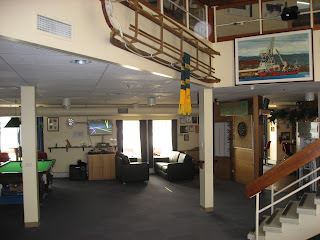Apologies for the gap between blogs – quite a bit has happened since the last post and this one. Anyhow here is the third submission.
On the 18th December we awoke at 0730 to a fire alarm. The previous night was the changeover of wintering crews, where the outgoing mob were given their Antarctic medallions and where the out going Station Leader presented the incoming Station Leader with the key to the station. So it was with some difficulty responding to the fire alarm by mustering downstairs in the ‘Wallow’ (large living area).
 |
| Front of the Wallow |
 |
| Rear of the Wallow |
The fire alarm ended up being a false alarm. It had been triggered by a lightning strike on the Green Store (and lightning strikes are extremely rare) and had been witnessed by a few who had been up and about at that time of morning.
Anyhow after returning to bed, an hour later another alarm sounded with a different tone and pitch. It was the SAR alarm indicating something serious. When we had all gathered again in the Wallow, the new Station Leader informed us that two of our male colleagues up at the Wilkins runway had been lost in a blizzard. Apparently they had left the mess and proceeded to conduct work in another van close by.
They had wind conditions of approximately 80knots (close to 150kph) and limited visibility. Both had been swept off their feet and slid along the ice and were separated from each other becoming lost and confused in the terrible conditions.
Down at station we were having similar conditions and in fact set a new record for wind gust at Casey with a speed of 202kph. Visibility was almost zero and no-one was allowed to travel out of the accommodation building alone. For example, I was required to move up to the radio room to cover the SAR teams departure and I had to have two escorts. Once I was 'delivered' to the radio room, then there were two together for safety reasons, who returned to the red shed.
 |
| Blizzard conditions on station |
Back up at Wilkins runway, the remaining 4 staff commenced conducting Search and Rescue procedures ensuring that they too did not become a casualty. After a number of hours of searching they realised that the situation looked extremely grim.
On station, we sent up two tracked vehicles called Hagg’s (Hagglund is the brand name of the vehicle). The two vehicles had professional field officers and equipped to conduct thorough search and rescues.
 |
| Tracked vehicle commonly used on the ice, known as a 'Hagg' (Hagglund) |
After a number of hours, it was reported one of the men had managed to crawl his way back to the mess and entered suffering severe exposure and frostbite. The whereabouts of the other expeditioner was still unknown.
Six hours later we still had no word of the remaining lost person. I personally had given up on finding him alive. So long in such extreme conditions did not bode well for a happy ending. As you can imagine the morale was becoming extremely low.
I had once summered at another station in 2005/06 where one of the expeditioners had committed suicide. The morale then plummeted and the feeling was very much the same this time with our lost colleague.
Anyhow, after almost 8 hours in the open, and finally deciding to lay low, curled up and attempt to wait out the conditions, the weather began to improve enough for him to make his way back to the mess.
What a relief for him, his family and also for us. The two Hagglund’s continued their way to the runway, one of which had the station doctor who was able to provide immediate medical assistance to both men and monitor their conditions.
The following day the weather cleared enough for the Hagg’s to return to station and for both men to be admitted to sickbay for further medical assistance. (As the weather began to clear the cloud formations and the light were just fabulous with many a good picture taken to capture the moment).
 |
| Looking down Main Street - Yellow building on the left in the distance is where the radio room is located |
 |
| Looking South - Green building is the Tank House (with spa and sauna) |
Having spoken to one of the men, he stated that he gave up twice thinking he was going to die. He had VHF radio and a GPS with him but his fingers were so cold that he could not operate any of the equipment. His radio was blown away at some stage but still the GPS was unable to be used. His wind proof jacket had blown up and filled with snow, his hands received severe frostbite, and other extremities (ears, nose, neck etc).
But with determination, and also using the skills taught to us during our trainings, he pushed as hard as he could and survived.
The first casualty suffered frostbite but not so badly as the second. He remains on station with us, in fact is back up at the runway working. However the second casualty has recently returned to Australia for further medical treatment. He flew from Casey to McMurdo Station (US Antarctic Station), then onto Christchurch and finally Australia.
Both are very, very lucky to be still alive and we are all relieved that they still are.

No comments:
Post a Comment